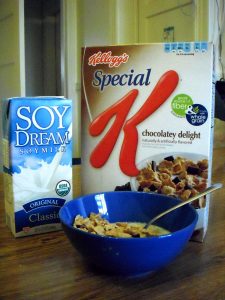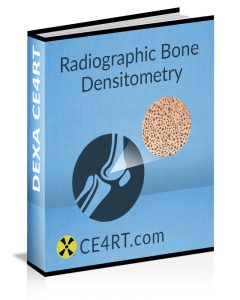Calcium Intake and Bone Health: Are You Getting Enough?

Most people know that calcium intake and bone health are intimately linked. But do you know how much calcium is necessary to maintain healthy bones? DXA operators may often be questioned by patients about ways to improve their bone density. It’s always a good idea to refer the patient to a physician or dietary consultant, but here’s a quick guide for radiologic technologists about calcium intake and bone health.
Nutrition for Bone Health
The Institute of Medicine has outlined recommendations for the intake of several nutrients that are vital to skeletal health. The most important is calcium intake and bone health. Other nutrients listed by the institute’s Food and Nutrition Board are vitamin D, magnesium, phosphorus, and fluoride. There are separate recommendations for the calcium intake and bone health in people of different ages. It should be noted that these recommendations have been developed keeping in mind healthy people with no underlying bone disease. Individuals with osteoporosis or other chronic conditions may have a higher calcium requirement. Unfortunately, these requirements have not been precisely defined.
Calcium Intake for Different Age Groups
Childhood and adolescence is a period of rapid bone growth. Consequently, calcium requirement is highest at this stage of life. The recommended daily calcium intake for good bone health is 1,300 mg every day for children and adolescents between the ages of 9 and 18. Women who are pregnant or lactating also need to consume a sufficient amount of calcium to meet the needs of the growing baby. However, excessive amounts of calcium can be detrimental to the individual’s health. The Institute of Medicine has defined 2,500 mg of calcium per day as the safe upper limit. In other words, consuming more than 2,500 mg of calcium a day can have adverse effects, especially in susceptible people.
Sources of Dietary Calcium
For Americans, the main source of calcium intake and bone health is from dairy products in the diet. In adults, consuming three 8-ounce glasses of milk every day in addition to the calcium in other foods is sufficient to meet the recommended daily requirement of calcium. It is advisable to consume low-fat or non-fat dairy products as these contain sufficient quantities of calcium but have a low fat content. Calcium-fortified foods, such as cereals and orange juice, are other good sources of this vital nutrient, especially for people who cannot consume dairy products.
Vegetables are a good source of calcium. However, the amount of calcium absorbed from each vegetable varies. For instance, the calcium in kale and broccoli is absorbed well by the body but the calcium in spinach is not. In addition, vegetables need to be consumed in very large quantities if they are the only source of calcium in a person’s diet. Thus, it is not practical for people to obtain their recommended daily calcium from vegetables.
In general, foods that contain 5 percent or less of the daily recommended value are known as low-calcium foods. Foods that contain 20 percent or more of the recommended daily value are known as high-calcium foods. It is possible for every individual to design and consume a diet that is both nutritionally adequate as well as appealing in taste. Adequate calcium intake and bone health are not difficult to achieve.
Calcium Intake and Lactose Intolerance
Many people are lactose intolerant. The condition is especially prevalent in non-Caucasians. This makes calcium intake and bone health a little challenging. People with this condition tend to avoid consuming dairy products as they cannot tolerate them well. Dairy is a good source of dietary calcium and people with lactose intolerance are thus prone to low calcium intake.
To ensure adequate calcium levels, people with lactose intolerance must consume other non-dairy foods that are good sources of calcium. It is also possible for such people to slowly build up tolerance to milk and other dairy products. Following this, their intestinal flora is able to digest the lactose without producing distressing symptoms.
Studies have shown that many people who are lactose intolerant are able to tolerate one cup of milk twice a day. This should be consumed in combination with other food. Moreover, dairy products such as yogurt and cheese, which are also good sources of calcium, are sometimes better tolerated than milk. They can support calcium intake and bone health. For individuals with severe lactose intolerance, other non-dairy sources of calcium such as fortified cereals and orange juice, lactose-free milk, and calcium-fortified soy products are useful additions to the diet.
Food Choices for Lactose Intolerant Individuals
Some food choices and diet modifications that lactose intolerant people can make to maintain adequate calcium intake and bone health include:
- Foods with high calcium content but low lactose content
- Vegetables such as bok choy, kale, and broccoli
- Calcium-fortified beverages such as orange juice
- Calcium-fortified cereals
- Canned fish such as anchovies, sardines, and salmon
- Soy foods such as tofu, edamame, and soy nuts
- Yogurt with live bacterial cultures (the bacterial lactase helps in digesting lactose)
- Colby, cheddar, parmesan, Swiss, and other hard cheeses (the production process breaks down the lactose making it easier to digest)
- Lactose-reduced or lactose-free dairy products
- Gradual increase in consumption of dairy and other lactose-containing foods

Measuring Calcium Intake
As mentioned, many Americans do not have adequate calcium intake and bone health. The following guide can be used to roughly calculate the calcium obtained by an adult from various sources and compare it to the recommended daily amount:
- Average calcium obtained from non-dairy food sources: 290 mg in females, 290 mg in males over the age of 60, and 370 mg in males under the age of 60
- Calcium from dairy and other calcium-rich food sources: 300 mg for each 8-ounce glass of milk or equivalent amount of yogurt, cheese, or ice cream
- Calcium from supplements and multivitamins: Dose as mentioned on the label multiplied by the number of doses per day
Reading Food Labels
Labels contain a lot of nutritional information, including the calcium content of the food. Reading and understanding food labels correctly is important for adequate calcium intake and bone health. For example, a 500-ml cup of yogurt contains two servings of 250 ml each. The nutritional facts may indicate that each serving (i.e., half the cup) contains 300 mg of elemental calcium.
Sometimes, the label may state that each serving provides 30 percent of the daily value. The daily value for each nutrient is calculated based on a 2000-calorie diet and therefore varies according to an individual’s calorie needs. However, an easy way to convert the percentage daily value of calcium mentioned on the food label to elemental calcium in milligrams is to add a 0 or multiply the percentage daily value by 10. In other words, a serving of food that provides 30 percent of the daily value of calcium contains 300 mg of calcium. In general, foods that provide 20 percent of the daily value or more are good sources of calcium and foods that provide 5 percent of the daily value or less are poor sources of calcium.
Calcium Supplementation
According to the Institute of Medicine, it is always better to obtain nutrients naturally from food rather than supplements. Therefore, dietary sources of calcium intake and bone health go hand in hand. This is because food contains a variety of nutrients that are good for not only the bones but the overall health of the individual. In people who are unable to consume a sufficient amount of dairy products and other foods that are naturally rich in calcium, supplements and fortified foods are useful to achieve the recommended intake of calcium. When calcium is taken in supplemental form, the following should be noted:
- The major forms of calcium supplements (citrate and carbonate) are absorbed better when taken with food
- Calcium from supplements and fortified foods is best absorbed in small doses of 500-600 mg at a time
- Different supplements are absorbed to a different degree depending on the manufacturing process
Studies have shown that supplements of comparable quality can vary in price by as much as fivefold. This has to be kept in mind when trying to find the most cost-effective calcium intake and bone health supplement. The most expensive supplement is not necessarily the best one. Evaluations have revealed that calcium carbonate is typically the least expensive supplemental source of calcium. It is also important to know that calcium supplements reduce iron absorption from the gut. Therefore, iron and calcium supplements should not be taken at the same time.
DXA Continuing Education
We offer several online courses for X-ray CE. To complete the continuing education requirements, DXA operators and radiologic technologists can purchase our online courses, take and easy post-test, and get a certificate of completion almost instantly. These e-courses are an easy and convenient way to Learn ARRT® CE credits. Our bone densitometry course offers comprehensive information and the chance to earn 23 credits in one go.
Here is details about x ray tech online courses.
